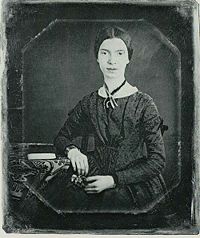Personification
a kind of metaphor that gives inanimate objects or abstract ideas human characteristics.
Bee! I'm Expecting You!
Emily Dickinson
Bee! I’m expecting you!
Was saying Yesterday
To Somebody you know
That you were due—
The Frogs got Home last Week—
Are settled, and at work—
Birds, mostly back—
The Clover warm and thick—
You’ll get my Letter by
The seventeenth; Reply
Or better, be with me—
Yours, Fly.
In “Bee! I’m expecting you!”, a poem by Emily Dickinson, personification is evident throughout the three stanzas. The first stanza personifies a bee, and how it was “saying Yesterday to Somebody [it] knew that [it] was due”. The second stanza personifies frogs, who “got home last week [and] are settled, and at work, birds who are “mostly back”. At the end of the poem the reader discovers that the narrator is actually a fly, and has written this poem as a letter to bee.

"Find ecstasy in life; the mere sense of living is joy enough." ~Emily Dickinson
Emily Dickinson

Emily or should I say Poetess Dickinson was born in Amherst, Massachuetts on December 10, 1830. Emily lived secluded in the house she was born in, except for the short time she attended Amherst Academy and Holyoke Female Seminary, until her death on May 15, 1886 due to Bright's disease.
Emily was an energetic and outgoing woman while attending the Academy and Seminary. It was later, during her mid-twenties, that Emily began to grow reclusive. She attended almost exclusively to household chores and to writing poetry.
Many scholars have tried to understand and theorize why Emily decided to seclude herself in her home and write about the most intimate experiences and feelings of life. I think that the best of these theories is that Emily could not write about the world with out first backing away from the it and contemplating it from a distance.
Emily had a few friends and acquaintances from day to day. One of these aquaintances was Thomas Wentworth Higginson whom she sent a few pieces of her poetry to. He rejected her poems, but he was eventually the first to publish her work after her death. Emily only had a six or seven of her poems published during her lifetime--and those without her consent. The number is argued over because one poem was published more than once.
It was after her death that her poems were discovered. It is estimated that Emily wrote over 1700 poems.
(http://www.cswnet.com/~erin/edbio.htm)
